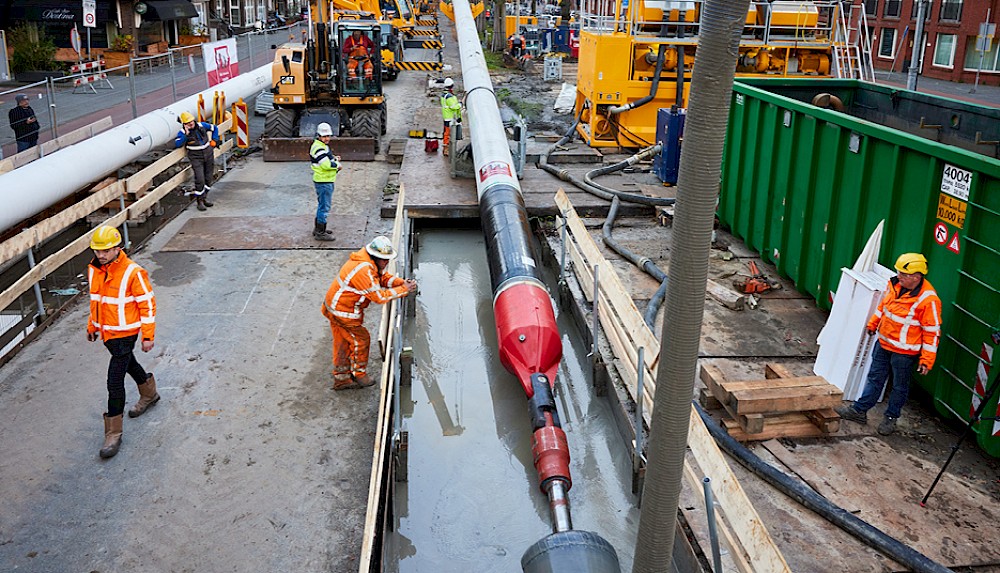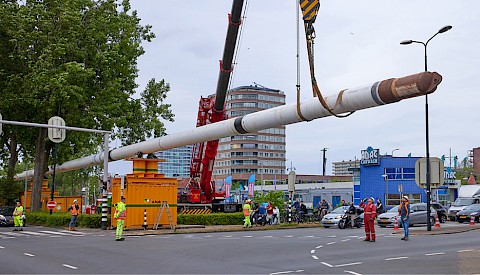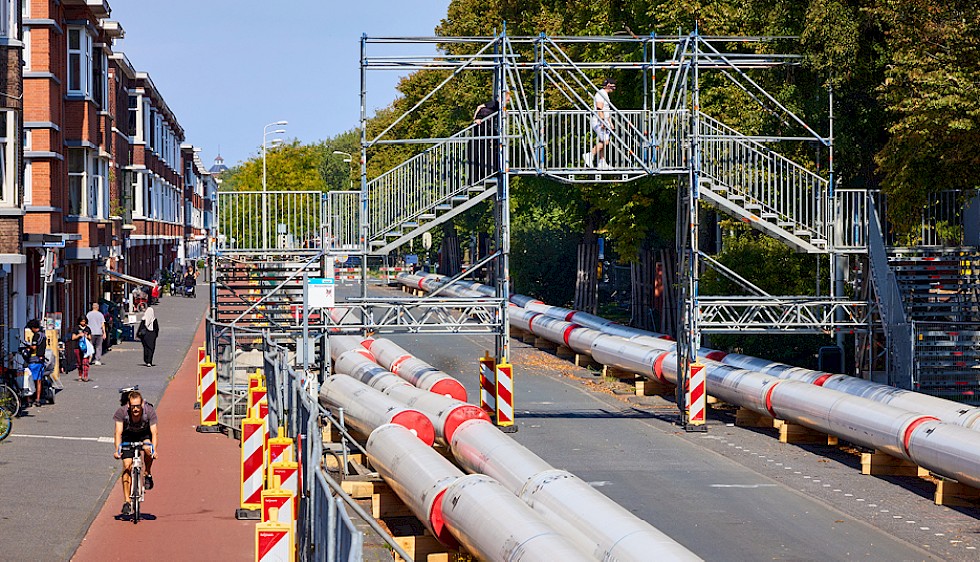Open for the transition in the heating sector
The exploitation of so far unused waste heat not only reduces the dependence on fossil fuels, but also decarbonises the heating sector at the same time. Thanks to open-grid and open-access schemes, the potential is huge, as two current examples in the Netherlands and Belgium show. HFI-welded steel pipes from Mannesmann Line Pipe are being used in both projects.
Heated interiors and hot water are an integral part of an energy supply for home comfort. The majority of households still use fossil fuels for this purpose.
A more efficient alternative to this is district heating. So far unused waste heat from industry, cooling plant and data centers offer tremendous potential as heat sources for district heating grids. Its industrial and commercial use can also significantly reduce energy requirements from fossil sources.
Decades of product and pipe-laying experience
As a supplier of medium and jacket pipes, Mannesmann Line Pipe has decades of expertise with internationally reputed manufacturers of district heating system pipes. This is backed up by technical knowledge and experience of a wide range of laying methods, from traditional trench laying to ploughing and horizontal directional drilling (HDD).

The work on WarmtelinQ is being carried out at up to 30 locations simultaneously.
Photo: © WarmtelinQ, Vincent Basler
The Netherlands – heat for the future
Located on the Rhine estuary south of The Hague, the port of Rotterdam is one of the world’s largest seaports. Since April 2022, pipeline network operator Gasunie has been building an extensive district heating network with WarmtelinQ in order to harness the residual heat from local industrial companies to sustainably heat private households, industry and commerce.
In the first section of the project, the heat pipeline will run from the port of Rotterdam via Vlaardingen to The Hague. The second section is to follow directly afterwards so as to supply parts of the 120,000-population City of Leiden with sustainable heat.
Looking ahead, several T-pieces will be installed along the route so that additional local heat generators and consumers and local distribution networks can be flexibly connected in due course. Using this open-grid approach, up to 500,000 residential units could ideally be connected to WarmtelinQ at some point in the future.

Wherever possible, the district heating pipes are assembled into long strings and laid trenchlessly for minimum environmental impact.
Work in progress
A period of 16 to 24 months was estimated for the 23 km long first Rotterdam-Vlaardingen-The Hague section. During this period, work is carried out at up to 30 different locations simultaneously.
This calls for meticulous production, delivery and construction site logistics in close consultation with the installation companies on site and FW Fernwärme Technik in Celle, the supplier of the district heating pipe system.
For the sophisticated pipe-in-pipe system pipes, Mannesmann Line Pipe supplied around 914 tonnes of HFI-welded steel pipes by September 2023. The various dimensions from DN 300 to DN 600 are fabricated to the tightest production tolerances (EN253) in Siegen and Hamm and, after passing the full-body ultrasonic test (EN10893), delivered just-in-time by HGV to FW Fernwärme-Technik in Celle for further processing. This is where the pipes for the system pipes proper, consisting of medium and jacket pipes, inclusive of insulation and roller beds, are produced and prepared for dispatch.

Always great interest in the laying of long pipe strings.
Photo: © WarmtelinQ, Vincent Basler
Extensive PR
To ensure a high level of acceptance for the large-scale engineering project from the outset and to dispel any concerns, Gasunie has kept citizens and stakeholders fully informed. At numerous on-site meetings and with a detailed, interactive website, all project stages are clearly explained and the most important questions answered: When and where will the work take place; how exactly are the pipes laid; and what disruption can residents, business people and commuters expect?
During the project, great importance is also attached to environmental compatibility. Along the planned route of the first section, for example, there are around 2,000 trees of different species and sizes. In consultation with the Tree Conservation Foundation in Vlaardingen, two large swamp oaks have been dug up and replanted elsewhere, for example.
Belgium – “Warmtenetwerk Antwerpen Noord”
Based in North Antwerp, the waste disposal company Indaver releases a great deal of heat during the thermal processing of industrial waste. Some of this is already being used for the company’s own business processes and to generate electricity. In future, however, the remaining residual heat is also to be put to sensible and sustainable energy use. The first step is therefore to build a district heating link to Boortmalt, the world’s largest malt group, 8 kilometers away. With an annual production capacity of 470,000 tonnes, the Antwerp site produces enough malt to brew around 16 billion beers. Malting and especially the drying processes require huge amounts of heat. From 2024, heat at a temperature of around 105°C will be fed from Indaver to Boortmalt.
Deliveries for medium and jacket pipes
For Isobrugg GmbH’s district heating system pipes in Lehrte, Mannesmann Line Pipe has supplied a total of 413 tonnes of HFI-welded steel pipes in diameters DN 400 and DN 600 for use as medium and jacket pipes. The customer’s technical specification focused primarily on the outer pipes with a diameter of 609 mm and a wall thickness of 8.8 mm, which were to be given an extra-strong PP coating conforming to ISO 21809-1 with a layer thickness of 6 mm.
In the run-up to this, project participants from Isobrugg, Salzgitter Handel in Hannover and Indaver Antwerp travelled to Siegen for a plant visit to see the production of steel pipes using the HFI method and the coating process at first hand.
The pipes were transported by truck to Isobrugg in Lehrte and from there by truck to the job site.
Just like WarmtelinQ, this heating network is also designed as an open access network. Immediately after completion of the first section, it will be extended and thus become an essential part of Antwerp’s urban climate policy towards climate neutrality. The client will then be the City of Antwerp itself, which will supply sustainable heat to major customers such as the Woonhaven social housing organisation with around 3,200 flats in the Luchtbal and Rozemaai districts, as well as schools and public buildings.
150 GWh of network capacity per annum
With the heating network operating at full capacity, the switch from fossil fuels to waste heat will reduce carbon emissions by around 80,000 tonnes per year. This is equivalent to the emissions of around 25,000 households.
Open for the transition in the heating sector
Thanks to its open design, local companies that emit or use heat can also be connected at a later date. This will tap further enormous carbon savings potential and reduce the dependence on natural gas and oil.
In terms of climate neutrality, both projects are excellent examples of how the transition to renewable heating can be achieved step by step, sustainably and successfully – with HFI-welded steel pipes from Mannesmann Line Pipe.









